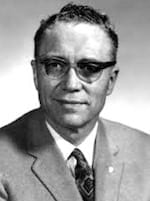Robert Andrew Hingson
Robert Andrew Hingson (1913-1996) was an American anesthesiologist.
Pioneer in anesthesiology best known for introducing caudal and epidural anesthesia into the practice of obstetrical anesthesia
Pioneer in humanitarian aid and public health. Founded Brothers’ Brother Foundation (BBF) an inter-faith volunteer group assisting in global humanitarian and immunisation efforts.
Combined forces with obstetric colleague Waldo B. Edwards to combine the advantages of continuous spinal anesthesia with the safety of extradural nerve block via the sacral hiatus to reach the peridural space.
Biography
- 1913 – Born in Annniston, Alabama
- 1938 – Graduated Doctorate of medicine from Emory University Atlanta, Georgia. Delivered 82 babies as a junior medical student; many of the mothers had no anaesthesia
- 1939 – Interned at the US Marine Hospital on Staten Island and joined the US Coast Guard as a Public Health Officer
- 1941 – Appointed Chief of Anesthesia at the US Marine Hospital, New York. Whilst looking after many military wives (and his own pregnant wife), he became interested in obstetric anesthesia
- 1945 – Professor of Anaesthesiology at the University of Tennessee in Memphis
- 1962 – Led a team that immunized a million people against smallpox in Liberia, West Africa.
- 1973 – Professor of Public Health at the University of Pittsburgh School of Medicine
- 1987 – Received the President’s Volunteer Action Award from President Ronald Reagan, for International Voluntarism
- 1991 – Recipient of the Gaston Labat Award from the American Society of Regional Anaesthesia
- 1996 – Died on the 9th October secondary to the complications of polymyositis.
Medical Eponyms
Hingson-Edwards caudal needle
Hingson Peace Gun – high-speed jet injectors, which can deliver precise dosages of medications, including local anesthetics and vaccines. Production-line immunization began in 1956 when Hingson and his team inoculated children with the Salk vaccine in Cleveland, Ohio. Eventually more than 300,000 patients were immunized via jet injection, primarily against polio and influenza
Western Reserve Midget – a portable manual respirator that is easy to carry and delivers a brief general anesthetic.
Major Publications
- Edwards WB, Hingson RA. Continuous Caudal Anesthesia in Obstetrics. JAMA. 1943; 121(4): 225-229.
- Edwards WB, Hingson RA. Continuous Caudal Anesthesia During Labor and Delivery. Anesthesia & Analgesia: 1942; 21(6): 301-311
- Edwards WB, Hingson RA. Continuous Caudal Analgesia in Obstetrics – A Method for Safe, Painless Childbirth. JAMA. 1943; 121(4): 260-261
- Hingson RA. The Western Reserve Portable Anesthesia Machine Resuscitator and Oxygen Inhalator as the Vehicle for Nonexplosive Cyclopropane-Helium-Oxygen Anesthesia. In: World Federation of Societies of Anesthesiologists. Proceedings: World Congress of Anesthesiologists. Scheveningen, The Netherlands, September 5-10, 1955: 150-152
- Hingson RA, Pitkin WM. Hypodermic injection device. JAMA. 1963 Apr 27;184:319
- Hingson RA. World Anesthesia: Problems confronting emerging countries. Anesth Analg. 1964; 43: 610-9.
- Hingson RA. [The world-wide federation of anesthesiologists societies diffuses the education of anesthesia and emergency care through the continents]. Anesth Analg (Paris). 1969; 26(4): 459-69.
- Hingson RA, Pitkin WM. Delivery of anesthesia services throughout the world. Clin Anesth. 1974; 10(3): 265-80
References
- Saxon W. Robert Andrew Hingson, 83, A Pioneer in Public Health. NY Times Oct 12, 1996.
- Maltby R. Notable Names in Anaesthesia. The Choir Press; pp95-97. 2013

